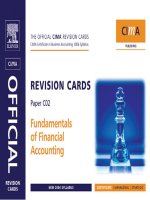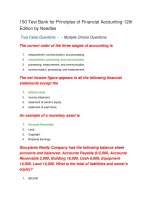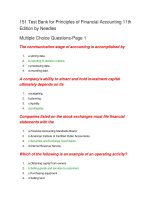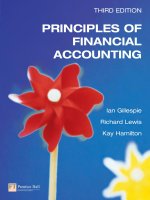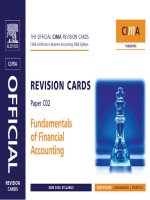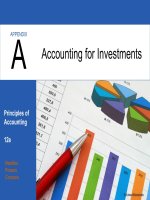Principles of financial accounting 12e by needles crosson chapter 15
Bạn đang xem bản rút gọn của tài liệu. Xem và tải ngay bản đầy đủ của tài liệu tại đây (339.77 KB, 21 trang )
CHAPTER
15
The Statement of
Cash Flows
Principles of
Accounting
12e
Needles
Powers
Crosson
©human/iStockphoto
Concepts Underlying the
Statement of Cash Flows
The s tate me nt o f c as h flo ws shows how a
company’s operating, investing, and financing
activities have affected cash during a period. It
explains the net increase (or decrease) in cash
during the period.
Cas h is defined as including both cash and cash
equivalents.
– Cas h e quivale nts are investments that can be quickly
converted to cash. They have a maturity of 90 days or less
when they are purchased and include the following:
Money market accounts
Commercial paper (short-term corporate notes)
U.S. Treasury bills
©2014 Cengage Learning. All Rights Reserved. May not be scanned, copied or duplicated, or posted to a publicly accessible website, in whole or in part.
Concepts Underlying the
Statement of Cash Flows
Cash equivalents should not be confused
with short-term investments, also called
marke table s e c uritie s , which have a
maturity of more than 90 days but are
intended to be held only until cash is needed
for current operations.
– Purchases of marketable securities are treated as
cash outflows, and sales of marketable securities
are treated as cash inflows.
– Transfers between the Cash account and cash
equivalents are not treated as cash inflows or
outflows.
©2014 Cengage Learning. All Rights Reserved. May not be scanned, copied or duplicated, or posted to a publicly accessible website, in whole or in part.
Relevance of the Statement of Cash Flows
The statement of cash flows provides information
about a company’s cash receipts and cash payments
during a period.
Management uses the statement of cash flows to:
assess liquidity; determine dividend policy; evaluate
the effects of major policy decisions involving
investments and financing needs.
Investors and creditors use the statement of cash
flows to assess a company’s ability to: manage cash
flows; generate positive future cash flows; pays its
liabilities; pay dividends and interest; anticipate the
need for additional financing.
©2014 Cengage Learning. All Rights Reserved. May not be scanned, copied or duplicated, or posted to a publicly accessible website, in whole or in part.
Classification of Cash Flows
Ope rating ac tivitie s —involve the cash inflows and
outflows from activities that enter into the
determination of net income.
– Cash inflows include:
Cash receipts from the sale of goods and services
Cash receipts from the sale of trading s e c uritie s —marketable
securities that a company buys and sells for making a profit in the near
term as opposed to holding them indefinitely for investment purposes.
Interest received on loans and dividends received on investments
– Cash outflows include:
Cash payments for wages, inventory, expenses, interest, and
taxes
Purchases of trading securities
©2014 Cengage Learning. All Rights Reserved. May not be scanned, copied or duplicated, or posted to a publicly accessible website, in whole or in part.
Classification of Cash Flows
Inve s ting ac tivitie s —involve the acquisition and
sale of property, plant, and equipment and other
long-term assets, including long-term investments.
– Cash inflows include cash received from:
Selling marketable securities, other than trading securities
Selling long-term assets
Collecting on loans
– Cash outflows include:
Cash expended on purchasing securities and assets
Cash lent to borrowers
©2014 Cengage Learning. All Rights Reserved. May not be scanned, copied or duplicated, or posted to a publicly accessible website, in whole or in part.
Classification of Cash Flows
Financ ing ac tivitie s —involve obtaining resources
from stockholders and creditors.
– Cash inflows include:
Proceeds from stock issues
Short-term and long-term borrowing
– Cash outflows include:
Repayments of loans (excluding interest)
Payments to owners, including cash dividends
– Treasury stock transactions are also considered financing
activities.
– Repayments of accounts payable or accrued liabilities are
not considered repayments of loans and are classified as
cash outflows under operating activities.
©2014 Cengage Learning. All Rights Reserved. May not be scanned, copied or duplicated, or posted to a publicly accessible website, in whole or in part.
Required Disclosure of Noncash Investing and
Financing Transactions
Companies occasionally engage in
significant no nc as h inve s ting and
financ ing trans ac tio ns .
– These transactions involve only long-term assets,
long-term liabilities, or stockholders’ equity.
– Although noncash transactions represent
significant investing and financing activities, they
are not reflected in the body of the statement of
cash flows because they do not affect current
cash inflows and outflows.
– They will, however, affect future cash flows, so
they must be dis clos e d in a separate schedule,
usually following the statement of cash flows.
©2014 Cengage Learning. All Rights Reserved. May not be scanned, copied or duplicated, or posted to a publicly accessible website, in whole or in part.
Alternate Presentations of Operating Activities
The dire c t me tho d converts each item on
the income statement from the accrual basis
to the cash basis.
©2014 Cengage Learning. All Rights Reserved. May not be scanned, copied or duplicated, or posted to a publicly accessible website, in whole or in part.
Alternate Presentations of Operating Activities
The indire c t me tho d does not require the
conversion of each item on the income
statement.
– It lists only the items necessary to convert net
income to cash flows from operations.
– Both analysts and companies overwhelmingly
prefer the indirect method, which is easier to
prepare.
©2014 Cengage Learning. All Rights Reserved. May not be scanned, copied or duplicated, or posted to a publicly accessible website, in whole or in part.
Preparation of the Statement of Cash Flows
Preparing a statement of cash flows involves
four steps:
Determine Cash Flows from Operating Activities
Determine Cash Flows from Investing Activities
Determine Cash Flows from Financing Activities
Prepare the Statement of Cash Flows
©2014 Cengage Learning. All Rights Reserved. May not be scanned, copied or duplicated, or posted to a publicly accessible website, in whole or in part.
Step One: Determining Cash Flows from
Operating Activities
Because the income statement is prepared on an
accrual basis, it does not reflect the inflow and
outflow of cash related to operating activities.
– To ascertain cash flows from operations, the figures on the
income statement must be converted from an accrual basis
to a cash basis.
– The indirect method focuses on adjusting items on the
income statement to reconcile net income to net cash flows
from operating activities. These items include:
Depreciation, amortization, and depletion
Gains and losses
Changes in the balances of current assets and current
liabilities
©2014 Cengage Learning. All Rights Reserved. May not be scanned, copied or duplicated, or posted to a publicly accessible website, in whole or in part.
Step Two: Determining Cash Flows from
Investing Activities
In this step, accounts involving cash receipts and
cash payments from investing activities are
examined individually. The object is to explain the
change in each account balance from one period to
the next.
– The following transactions pertain to Eureka’s investing
activities in 2014:
1. Purchased investments in the amount of $78,000.
2. Sold for $102,000 investments that cost $90,000.
3. Purchased plant assets in the amount of $120,000.
4. Sold for $5,000 plant assets that cost $10,000 and that had
accumulated depreciation of $2,000.
5. Issued $100,000 of bonds at face value in a noncash exchange for
plant assets.
©2014 Cengage Learning. All Rights Reserved. May not be scanned, copied or duplicated, or posted to a publicly accessible website, in whole or in part.
Step Three: Determining Cash Flows from
Financing Activities
Determining cash flows from financing activities is
very similar to determining cash flows from investing
activities, but the accounts analyzed relate to shortterm borrowings, long-term liabilities, and
stockholders’ equity.
– The following transactions pertain to Eureka’s financing
activities in 2014:
1. Issued $100,000 of bonds at face value in a noncash
exchange for plant assets.
2. Repaid $50,000 of bonds at face value at maturity.
3. Issued 15,200 shares of $5 par value common stock for
$175,000.
4. Paid cash dividends in the amount of $7,000.
5. Purchased treasury stock for $25,000.
©2014 Cengage Learning. All Rights Reserved. May not be scanned, copied or duplicated, or posted to a publicly accessible website, in whole or in part.
Cash Flow Ratios
Cash flows from operating activities represent the
cash generated from current or continuing
operations.
– They are a measure of the ability to pay bills on time and to
meet unexpected needs for cash, as well as how
management spends the company’s cash.
The focal point of cash flow analysis is on cash
inflows and outflows from operating activities.
– These cash flows are used in ratios that measure c as hg e ne rating e ffic ie nc y, which is a company’s ability to
generate cash from its current or continuing operations.
©2014 Cengage Learning. All Rights Reserved. May not be scanned, copied or duplicated, or posted to a publicly accessible website, in whole or in part.
Cash Flow Yield
Cas h flo w yie ld is the ratio of net cash flows
from operating activities to net income.
©2014 Cengage Learning. All Rights Reserved. May not be scanned, copied or duplicated, or posted to a publicly accessible website, in whole or in part.
Cash Flows to Sales
Cas h flo ws to s ale s is the ratio of net cash
flows from operating activities to net sales.
©2014 Cengage Learning. All Rights Reserved. May not be scanned, copied or duplicated, or posted to a publicly accessible website, in whole or in part.
Cash Flows to Assets
Cas h flo ws to as s e ts is the ratio of net cash
flows from operating activities to average
total assets.
©2014 Cengage Learning. All Rights Reserved. May not be scanned, copied or duplicated, or posted to a publicly accessible website, in whole or in part.
Free Cash Flow
Fre e c as h flo w is the amount of cash that remains
after deducting the funds a company must commit to
continue operating at its planned level.
– Free cash flow can be positive or negative:
Pos itive fre e cas h flow means that the company has met all of
its planned cash commitments and has cash available to
reduce debt or to expand.
Ne gative fre e cas h flow means that the company will have to
sell its investments, borrow money, or issue stock in the short
term to continue at its planned level. If a company’s free cash
flow remains negative for several years, it may not be able to
raise cash by issuing stocks or bonds.
©2014 Cengage Learning. All Rights Reserved. May not be scanned, copied or duplicated, or posted to a publicly accessible website, in whole or in part.
Asking the Right Questions About the
Statement of Cash Flows
In interpreting a statement of cash flows, it pays to
know the right questions to ask.
– Cash Flows and Net Income: W hat are the prim ary re as ons
that the com pany’s cas h flows from ope rating activitie s
diffe re d from ne t incom e ?
– Investing Activities: W hat we re the com pany’s m os t
im portant inve s ting activitie s othe r than capital
e xpe nditure s ?
– Financing Activities: How did the com pany m anage its
financing activitie s during the ye ar?
– Cash Flow Trends: W hat has be e n the tre nd of cas h flows
for the com pany?
©2014 Cengage Learning. All Rights Reserved. May not be scanned, copied or duplicated, or posted to a publicly accessible website, in whole or in part.
Ethical Considerations in Analyzing the
Statement of Cash Flows
Because of the emphasis on cash flows as an
important measure of performance, an incentive
exists to overstate these cash flows.
A company may show an apparent (but false)
improvement in its performance:
– by classifying payments of operating expenses as
investments on the statement of cash flows.
– through lack of transparency, or lack of full disclosure, in its
financial statements—such as by netting the proceeds of
securitization against the accounts receivable in the
operating activities section of the statement of cash flows.
©2014 Cengage Learning. All Rights Reserved. May not be scanned, copied or duplicated, or posted to a publicly accessible website, in whole or in part.
